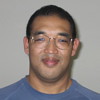Lewis's Moneyball gave an inside view on the economics of Major League Baseball by telling the story of Billy Bean's Oakland A's. The Blind Side explains the rise in importance of the Left Tackle through the story of Michael Oher.
And it begins over a year before Oher was born, but in the middle of the story.
From the snap of the ball to the snap of the first bone is closer to four seconds than to five. One Mississippi: The quarterback of the Washington Redskins, Joe Theismann, turns and hands the ball to running back John Riggins. He watches Riggins run two steps forward, turn, and flip the ball back to him...
... Two Mississippi: Thesmann searches for a receiver but instead sees Harry Carson coming straight at him....
... Three Mississippi: Carson now sees that Theismann has the ball. Theismann notices Carson coming straight at him, and so he has time to avoid him. He steps up and to the side and Carson flies right on by and out of th eplay. The play is now 3.5 seconds old.
[...]
You don't think of fear as a factor in professional football. You assume that the sort of people who make it to the NFL are immune to the emotion. [...] The head coach of the Giants, Bill Parcells, didn't think it preposterous, however. Parcells... believed that fear played a big role in the game. So did his players. They'd witnessed up close the response of opposing players to their own Lawrence Taylor.
[...]
The feelings of those assigned to prevent Taylor from hurting quarterbacks were trivial compared to those of the quarterbacks he wanted to hurt. In Taylor's first season in the NFL, no official records were kept of quarterback sacks. In 1982, after Taylor had transformed the quarterback sack into the turning point of a football game, a new official NFL statistic was born. The record books defined the sack as tackling the quarterback behind the line of scrimmage as he attempts to pass. Taylor offered his own definition: "A sack is when you run up behind somebody who's not watching, he doesn't see you, and you really put your helmet into him. The ball goes fluttering everywhere and the coach comes out and asks the quarterback, 'Are you all right?' That's a sack."
[...]
"I don't like to just wrap the quarterback, I really try to make him see seven fingers when they hold up three. I'll drive my helmet into him, or, if I can, I'll bring my arm up over my head and try to axe the sonuvabitch in two. So long as the guy is holding the ball, I intend to hurt him.... If I hit the guy right, I'll hit a nerve and he'll feel electrocuted, he'll forget for a few seconds that he's on the football field."
The game of football evolved and here was one cause of it's evolution, a new kind of athlete doing a new kind of thing. All by himself, Lawrence Taylor altered the environment and forced opposing coaches ans players to adapt.
[...]
Parcells became a connoisseur of the central nervous system of opposing quarterbacks. The symptoms induced by his sack-happy linebacker included, but were not restricted to: "intimidation, lack of confidence, quick throws, nervous feet, concentration lapses, wanting to know where Lawrence is all the time." The players on the Giants' defense picked up the same signals. As defensive back Beasley Reece told the New York Times, "I've seen quarterbacks look at Lawrence and forget the snap count." One opposing quarterback, finding himself under the center before the snap and unable to locate Taylor, called a time-out rather than run the play--only to find Taylor standing on the sidelines.
[...]
By his fourth pro season Taylor was not just feeding those fears, but feeding off them. "They come to the line of scrimmage and the first thing they do is start looking for me," he said. "I know and they know. When they'd find me they'd start screaming: 56 left! 56 left! [Taylor wore No. 56.] So there's this thing I did. After teh play was over, I'd come up behind them and whisper: don't worry where I am. I'll tell you when I get there."
[...]
Four Mississippi: Taylor is coming. From the snap of the ball Theismann has lost sight of him. He doesn't see Taylor carving a wide circle behind his back; he doesn't see Taylor outrun the blocker upfield and then turn back down; and he doesn't see the blocker diving, frantically, at Taylor's ankles. He doesn't see Taylor leap, both arms over his head, and fill the sky behind him. Theismann prides himself on his ability to stand in the pocket and disregard his fear. He thinks this quality is a prerequisite in a successful NFL quarterback. "When a quarterback looks at the rush," he says, "his career is over." Theismann has played in 163 straight games, a record for the Washington Redskins. He's led his team to two Super bowls, and won one. He's thirty-six years old. He's certain he still has a few good years left in him. He's wrong. He has less than half a second.
Next time, the beginning of the story: Bill Walsh and the quarterback

No comments:
Post a Comment